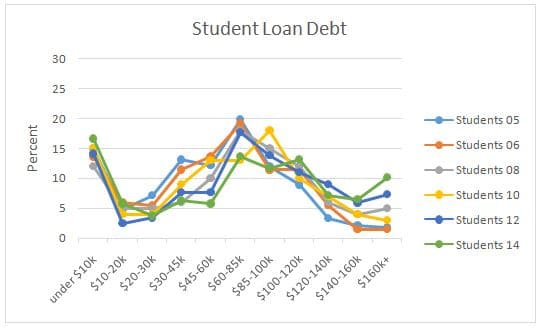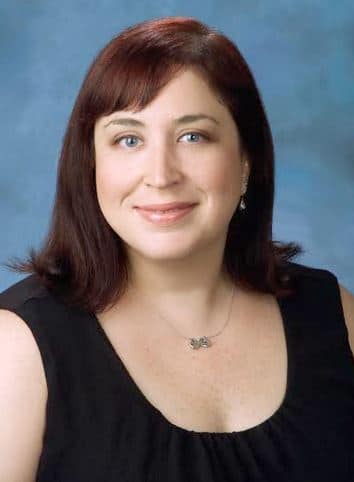Editor’s Note: Today’s post by Patricia Gaffney, AuD, continues the ongoing discussion over the cost of audiology education that has been addressed in multiple posts at HHTM over the years, including a 4–part series in Hearing Economics in 2013. In today’s post, Dr. Gaffney brings us some interesting data to consider and provides a look at how student loan amounts carried by AuD students and grads have changed since 2005.
By Patricia Gaffney, AuD
Student loan debt has become a considerable concern for students in audiology. Many students have had to take out federal and private loans to pay for their education. The rising cost in higher education is well known and student loan debt seems to follow a similar trend for the past decade.
An online survey was conducted across Doctor of Audiology (AuD) students and graduates from residential programs in 2005, 2006, 2008, 2010, 2012, and 2014. The number of students and graduates surveyed is shown below in Figure 1:

Figure 1: The number of AuD students and graduates that took part in a national online survey from 2005-2014
We can then visually see the overall student debt accumulated for first through fourth year AuD students plotted in Figure 2:

Figure 2: Total loan debt accumulated by AuD students in survey years 2005-2014
Figure 2 shows us the estimation of expected debt that will be owed by students upon graduating with their AuD. This amount includes undergraduate expenses. Only approximately 10-15% of students estimate they will owe less than $10,000 when they are done; the large majority of students will be taking out much more than that in loans.
The other important detail is looking at both the peaks of student loan debt amounts over time, as well as the top end ($160k+).
The peak debt was $60-85k in student loans, however, over time this has slightly increased to $85-100k.
Most importantly is looking at $160k+; this percentage has increased from less than 5% to over 10%. Figure 3 (below) shows a good example of progression of student loan amounts over the past decade.

FIgure 3: Comparing 1st year and 4th year AuD debt levels in 2005 vs. 2014
In Figure 3 we see the amounts that first year students currently have in 2005 and 2014, essentially the debt levels they carried at the entrance to doctoral program. In the first year both sets of students have a large percentage of loans in the “under $10k” amount. A number of students do retain that low loan amount by the fourth year; however, the peak loan amount in 2005 for fourth year students was $30-45k, while in 2014 the peak amount was $60-85k.
In 2005 only 1% of fourth year AuD students had $160k+ in student loan debt, compared to 11% in 2014.
In Figure 4 (below) we observe graduate loan amounts–keeping in mind this is collapsed across graduation year and is separated by response year. Although the data is more variable, the trend seen in students is evident in the graduates.

Figure 4: Loan debt for AuD graduates during survey years 2005-2014
So What Does this Mean for Audiology Students?
A report by the College Board revealed that the rising cost in education has been dramatic. From 1984-5 to 2014-5 public college education has increased 225% and private education has increased 146%.1

Figure 5: Comparing annual AuD program tuition across 6 universities
In Figure 5 (above) we observe the annual cost per year of tuition for six different AuD programs around the country, with a mixture of private and public universities, as pulled from university websites in April 2016.
The out-of-state tuition represents either out-of-state resident cost or if there is no difference between in/out of state (ex. Private schools). The average of these six schools is $25k per year for out-of-state tuition; four years alone is $100k in education. Cost of education will continue to rise, but the real issue is whether salaries are keeping up with the rise in education costs.
The Bureau of Labor and Statistics lists the mean audiology salary in 2015 as $74,890.2 The Academy’s 2005 Compensation and Benefits Report3 revealed a mean total compensation of those with a 4th year AuD as $52,812 and in the 2013 Compensation and Benefits Report4 the mean increased $77,758.
The data suggests a salary increase of approximately 47% since 2005. This is great; however, when comparing a 47% rise in salaries vs. 140%+ rise in cost of education, over time students are left with significant gap between loans and salary.
What is the answer?
The answer is complicated and a long road. Universities are under federal pressure to evaluate the cost of education, but as a profession this is more or less out of our hands. As audiologists we must work towards increasing reimbursements. This means audiologists should be contacting their state representatives in Congress to talk about audiology related bills, completing surveys put out by the major audiology organizations related to billing, coding, and reimbursement, supporting organizational government relations/PACs, and structuring our clinics to be autonomous in our profession and own what we do.
In the future we will continue to see education costs and salaries rise, but the goal will be to have them rise more proportionately than they have over the past decade.
References:
- Average Rates of Growth of Published Charges by Decade. (2015). Retrieved July 10, 2015, from https://trends.collegeboard.org/college-pricing/figures-tables/average-rates-growth-published-charges-decade
- Bureau of Labor Statistics, U.S. Department of Labor, Occupational Outlook Handbook, 2016-17 Edition, Audiologists. Retrieved April 21, 2016, from https://www.bls.gov/ooh/healthcare/audiologists.htm
- American Academy of Audiology (Dec 9, 2005). 2005 Compensation and Benefits Report. Precision Reports. Brainbridge Island, WA.
- American Academy of Audiology (Jan 14, 2014). 2013 Compensation and Benefits Report. Sector Intelligence. Washington, DC.
*Title image courtesy marketmadhouse

Patricia Gaffney, AuD, is an Associate Professor in the Department of Audiology at Nova Southeastern University (NSU) in Fort Lauderdale, Florida.






